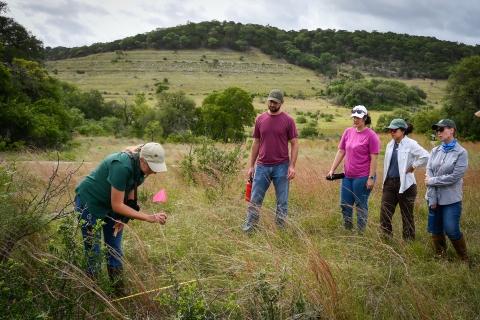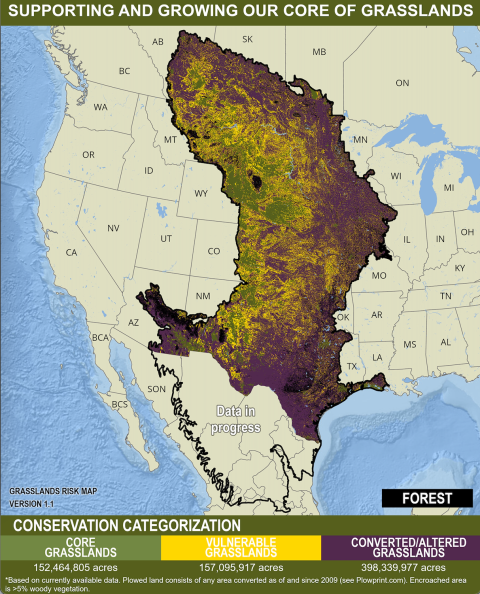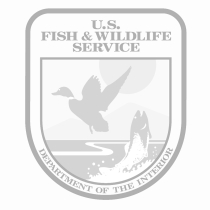Ways to get involved
The challenges to our grassland ecosystems are big and addressing these challenges will take time, continued investment, and ongoing coordination among partners.
Our Partners
While we will continue to prioritize the Service’s investments in the Central Grasslands, the challenges to this landscape are impossible to overcome alone. As a partner in this greater effort, the Service is contributing to the collective effort to conserve this vital landscape.
One of our priorities across the Department of the Interior is bringing together diverse communities and interests to solve our greatest conservation challenges. Leveraging individual strengths to find innovative opportunities for our natural world to thrive.
We are working alongside international partners, including Tribes and First Nations, as well as federal, state, and local public land managers, industry, NGOs, and private landowners to slow the loss of grasslands in the U.S. Canada, and Mexico. The Service is working to coordinate grassland conservation on an international scale by participating in the Trilateral Committee for the Wildlife and Ecosystem Conservation and Management and Commission on Environmental Conservation.
With 84% of central grasslands in the United States in private ownership, farmers and ranchers play a key role in grasslands and species conservation.
The Service’s Partners for Fish and Wildlife Program works with USDA to deliver resources available through the Farm Bill conservation programs to private landowners for habitat conservation on working lands, including the conservation of grasslands. We are coordinating with agencies such as the USDA’s Natural Resources Conservation Service and the Western Association of Fish and Wildlife Agencies to ensure our actions align and complement these partners’ range-wide strategies.
Read about some of our work with private landowners in the grasslands:
Stewards of the Land: Ranchers on the Front Lines of Conservation
Stewards of the Land: Craig Larson, ‘Banker by Day, Farmhand by Weekend’
Stewards of the Land: Kunz Farm, A Story of the Great American West
Partners For Fish and Wildlife Restores Thousands of Acres for Texas Wildlife in 2022
The Service’s planning and delivery of conservation and management of habitats relies on close collaboration with external partners and stakeholders, including private landowners and the JV8 Central Grassland Conservation Initiative collaborating to reduce grassland loss. The JV8 Central Grasslands Initiative has developed a StoryMap that provides an overview of North American grassland loss and the impacts associated with losing this critical ecosystem.
Central Grasslands Roadmap
The Central Grasslands Roadmap (Roadmap) is a partnership developed to guide increased conservation of North America's Central Grasslands, which span 700 million acres across Indigenous Lands, Canada, the United States and Mexico. By bringing together diverse nations and seven partnership sectors, the Roadmap has identified a shared vision, common principles, and collaborative priorities for the many people and organizations living and working on the Central Grasslands.
The Service supports the Roadmap through our collaborative efforts, our Partners for Conservation work, and by working on FWS managed lands to implement conservation actions that aim to conserve, restore, and protect critical grasslands. The Services R6 Grassland Ecosystems Team (GET) represents a multi-disciplinary effort across the Service to coordinate strategic and collaborative conservation in the Central Grasslands Ecosystem and helps integrate FWS efforts under the Roadmap. In tandem with the Central Grasslands Roadmap partnership, and guided by the priority areas identified in the Central Grasslands Assessment Map, the GET will leverage all funding opportunities, partnerships, and available resources towards protecting and restoring this ecosystem. The GET will guide investments in research, technology transfer, and conservation implementation and will help raise awareness of the critical importance of conserving grasslands to landowners, government agencies, NGOs, and the American public.
Roadmap partners from Canada, Mexico, the U.S. and Indigenous/First Nations Include:
Ranching and Agriculture
Foundations & Funders
Industry
Conservation & Nongovernmental Organizations
Academia
Federal agencies
State/Provincial Agencies
The Roadmap represents the innovative and collaborative solutions that are generated when diverse communities come together with passion for a common goal. We celebrate the Central Grasslands Roadmap and our collective commitment as federal, state and provincial agencies, Tribes and First Nations, producers and private landowners, foundations, industry, and nongovernmental organizations from Mexico, Canada and the U.S. to conserve North America’s Central Grasslands for the people, wildlife, and economies they support.
The Central Grasslands Assessment Map was developed by the Central Grasslands Roadmap partnership, which is a consortium of partners spanning international and Tribal government agencies, non-profits, and universities. This map shows where we can work together to avoid further degradation within grassland core areas and change the trajectory of our vulnerable grasslands to ensure they remain productive for people and wildlife. The definition of a ”core” grassland may vary across the biome. Small grasslands patches that are the only grasslands remaining in an area can be considered core grassland as well as larger landscapes of remaining grass.
The assessment map guides where voluntary conservation investments are needed. This provides a baseline metric for conservation goals, and targets zones where management practices could be most impactful. Local partners and community members are invited to use the map to prioritize short and long-term conservation programs.













